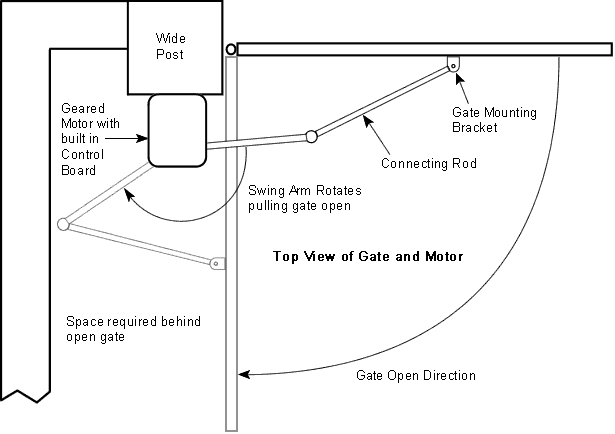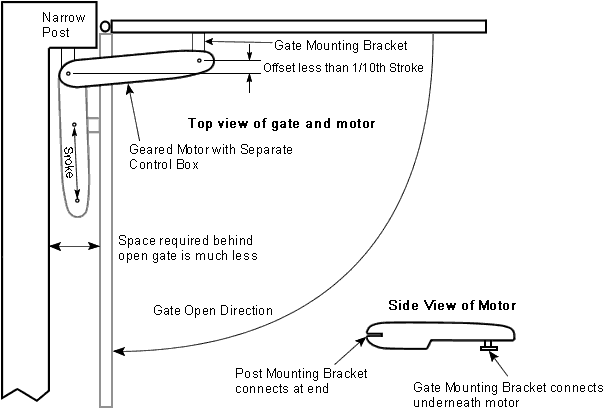
Different Configurations of Swing Gate Operators (Motors)
Operators for swing gates come in various different configurations depending on the size and layout of gate and the post it's hung from. They all include an electronic control unit either built into the operator or in a separate box called a control box. They also have an electric motor and drive unit that is either all in the one unit or is a separate unit called a 'Motor', 'gear Motor' or 'Actuator'. All configurations maybe used for outward opening gates with the motor inside the property or rising gates, although special mounts maybe required for some configurations with rising gates.
The different configurations are as follows:
Articulated arm (also known as 'Knuckle Arm' or 'Rotating Arm')
Is basically a box fitted to a wall/post or free standing pedestal and include: an electronic control unit, electric motor, gear box and articulated arm drive unit that extends out from the operator connecting to the gate with a connecting rod or arm. When powered up the articulated arm rotates moving the gate with it via the connecting rod. For double gates there is a slave motor with no control unit as it is powered from the Master operator to keep both sides synchronised.
Articulated Arm Operators are the easiest to install because there is no control box to fit and the positioning of the motor isn't as critical as worm drive motors. The only electrical installation work for single swing gates is for the supply of power to the operator, although with double gates a low voltage cable is still required across the driveway. Articulated arm operators are also the most tolerant to dusty or corrosive environments such as gravel roads or salty air from the ocean, requiring no maintenance.
Mechanically Smooth Motion the gate naturally moves slower at the fully open and close positions and faster mid cycle because of the mechanical geometry between the articulated arm and connecting rod, making a naturally smooth motion that reduces wear and tear. Although this doesn't come into play if the gate is reversed mid-cycle when the gate has to start moving in top gear so to speak. Worm drive motors rely on electronic speed control so the soft start and stop is the same no mater what position the gate is in.

Draw backs of articulated arm operators is they do require plenty of space behind the gate when open, require large custom made mounting plates if fitting to narrow gate posts and if the gate has a solid infill such as metal sheeting they aren't so good with the wind as they tend to run faster mid-cycle with less torque so if a strong wind hits the gate at this point the motor can't handle it as well as worm drive swing gate motor.
Maintenance an advantage of articulate arm operators is they can be close to the ground without worry of any dust or dirt getting splashed up into the drive mechanism because they are generally well sealed.
In the ground
These have a box that fits in the ground with a shaft that extends up and fits to the bottom of the gate acting as the bottom hinge and directly driving the gate. The biggest issue with these is the fact that they need to be fitted in the ground and they need to be very well sealed from the weather so tend to cost more although the advantage is you can't see them.
Open Worm Drive (also known as just 'Worm Drives')
These have the electronic control unit in a separate box to the motor. The motor actually consists of an electric motor, gear box, a worm and nut drive or acme screw drive as the engineers call it, with the casing of the motor open at the bottom so the nut can connect to a gate mounting bracket making the motor quite short in length so is ideal for narrower gates. The electric motor and gear box rotate the worm and the nut moves in a linear direction, which either pushes or pulls the gate open or closed, rather than the rotational movement of the articulated arm. These are also quite tolerant to dusty and corrosive environments requiring little maintenance. Fitting of these is more difficult than the articulated arm because the positioning of the motors mounting point on the post is more critical, although Grant's Automation has four different sets of mounting brackets to suit common gate and post arrangements to simplify the whole process.

The biggest drawback with the open worm drive motor is the casing of the motor extends past the gate mounting bracket when the gate is opening, so the gate mounting bracket needs to be long enough so the casing does contact the gate as this would stop it working.
The electrical wiring required is for power to the control box and then a low voltage cable run from the control box to each motor. The number of cores for the motor cable varies depending ion the motor. Some require only two cores, whereas others up to six cores.
Maintenance if the operator is fitted in the middle of the gate rather than the bottom it won't have any dust or dirt splashed up into the worm drive by the weather so won't require any maintenance.
Maintenance in General
If a gate operator runs off a battery or has a battery backup the battery will need to be replaced every 3 to 5 years. Operators that don't have a battery are more desirable from a maintenance point of view although batteries are readily available and easily replaced so isn't really an issue.
Piston Worm Drive (also known as 'Tubular') or Hydraulic Ram.
These also have a separate control box and the electric motor either powers a worm and nut drive or hydraulic piston that drives a translating tube sliding inside a cover tube like a piston. As the worm drive turns or hydraulic pressure applied by electric pump the translating tube is moved in a linear direction.
Fitting of these is more difficult than the articulated arm because the positioning of the motors mounting point on the post is more critical, although Grant's Automation has four different sets of mounting brackets to suit common gate and post arrangements to simplify the whole process.
Linear Piston Worm Drives are the most versatile because the cover of these doesn't extend past the gate mounting bracket so the gate mounting bracket can be quite short allowing the motor to fit into a tighter space behind an open gate, intrude less into the driveway for outward opening gates and have wider opening angles.

The only issues with these is the translating tube needs lubrication with a fine penetrating oil every now and then and the more dusty the environment they are in the more often this is necessary. They also tend to be quite long, which is good from mechanical point of view but motors with a shorter amount of linear travel must be used on narrower gates.
Maintenance these operators do need regular maintenance that is the drive tube does need to be kept clean and lubricated. The seal for the drive tube can dry up and get a build up of dust or dirt from the weather so just needs any build up cleaned of and a squirt with some penetrating oil like WD-40 every now and then particularly if it starts to run slow or get noisy.